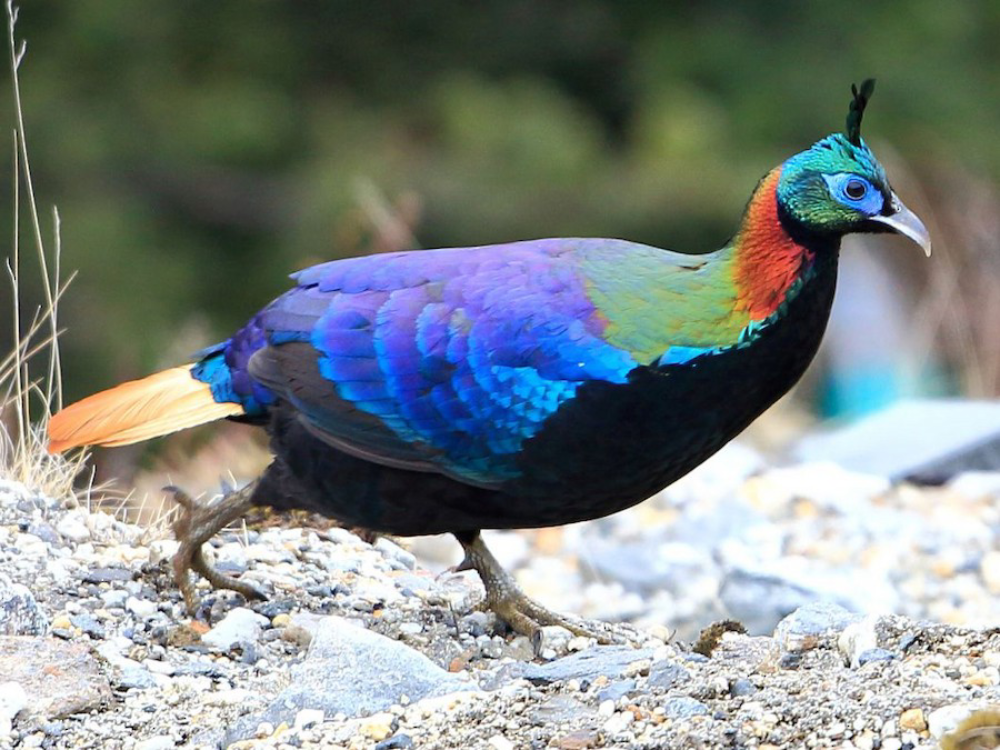Physical Characteristics
The male Himalayan Monal is particularly notable for its vibrant colors, which include a metallic green head, a white back, and a multicolored body with shades of blue, green, purple, and red. This remarkable coloration makes it one of the most visually stunning birds in the world. The female, while more subdued in her brownish-black plumage, possesses a beauty that is perfect for her environment, providing effective camouflage among the forest undergrowth.
One of the most striking features of the male Monal is its crest, a cluster of metallic green feathers that extend from the top of its head. The bird’s long, curved tail feathers add to its grandeur, making it an emblem of the rich biodiversity of the Himalayan region.
Habitat and Distribution
The Himalayan Monal inhabits a range of altitudes from 2,100 to 4,500 meters (6,900 to 14,800 feet), primarily in the dense coniferous and mixed forests of the Himalayas. Its range extends across several countries, including India, Nepal, Bhutan, and southern Tibet. The bird’s habitat preferences change with the seasons; it descends to lower altitudes during the winter to avoid the harsh conditions of the higher elevations.
The species’ adaptability to various elevations and its preference for rugged, remote terrains help it evade many predators. However, this also makes it challenging for researchers to study and monitor the bird extensively.
Behavior and Diet
Himalayan Monals are ground-dwelling birds, although they are capable of powerful bursts of flight. They are popular for their shy and elusive nature, often retreating into dense undergrowth at the slightest disturbance. The diet of the Himalayan Monal is omnivorous, consisting of a variety of items such as roots, tubers, seeds, insects, and small invertebrates. During the winter months, when food is scarce, they dig through snow to uncover roots and other edible plant material.
Monals are also known to forage in agricultural fields, which sometimes brings them into conflict with local farmers. However, their role in controlling insect populations and contributing to seed dispersal underscores their ecological importance.
Reproduction and Lifespan
The breeding season for the Himalayan Monal typically begins in April and lasts until June. During this period, males perform elaborate courtship displays to attract females. These displays involve fanning their tails, strutting, and producing a range of vocalizations and physical postures to showcase their vibrant plumage. Once a pair has formed, the female selects a nest site, usually a shallow depression in the ground, lined with leaves and grass.
A typical clutch consists of three to five eggs, which the female incubates for about 27 days. During this time, the male remains nearby to guard against predators. After hatching, the chicks are precocial, meaning they are relatively mature and mobile from the moment they emerge. They rely on their mother for warmth and protection, but they can forage independently within a few days.
The lifespan of a Himalayan Monal in the wild is not well-documented but is estimated to be around ten years. In captivity, where threats from predators and harsh environmental conditions are mitigated, they can live longer.

Conservation Status and Threats
The Himalayan Monal is classified as “Least Concern” by the International Union for Conservation of Nature (IUCN). However, it faces several threats that could impact its population if not addressed. Habitat loss due to deforestation, agricultural expansion, and infrastructure development poses significant risks. Additionally, the bird is hunted for its feathers, which are highly valued for decorative purposes and traditional costumes.
Climate change also presents a long-term threat to the Himalayan Monal. Alterations in temperature and precipitation patterns could affect the availability of food and suitable habitats, potentially forcing the birds to move to even higher altitudes, where conditions might be less favorable.
Conservation efforts for the Himalayan Monal include habitat protection, anti-poaching measures, and awareness campaigns to highlight the bird’s ecological and cultural importance. Protected areas such as national parks and wildlife sanctuaries in the Himalayas provide critical refuges for the species.
Cultural Significance
The Himalayan Monal holds considerable cultural significance in the regions it inhabits. In Nepal, it is revered and celebrated, featured in folklore, art, and traditional ceremonies. The bird’s image is often used in local crafts, textiles, and ornaments, symbolizing beauty and grace. Similarly, in the Indian state of Uttarakhand, the Monal is a symbol of natural heritage and is prominently featured in local art and cultural expressions.
In addition to its symbolic value, the Himalayan Monal plays an important role in eco-tourism. Bird watchers and nature enthusiasts from around the world visit the Himalayas in hopes of catching a glimpse of this magnificent bird in its natural habitat, contributing to the local economy and promoting conservation awareness.
Conclusion
The Himalayan Monal is more than just a bird. It is a vibrant symbol of the rich natural and cultural tapestry of the Himalayas. Its dazzling appearance, elusive behavior, and ecological significance make it a subject of fascination and importance. While it faces several threats, ongoing conservation efforts and the cultural reverence it enjoys offer hope for its continued survival. Protecting the Himalayan Monal and its habitat ensures that future generations can continue to marvel at this jewel of the mountains, preserving both biodiversity and cultural heritage.









